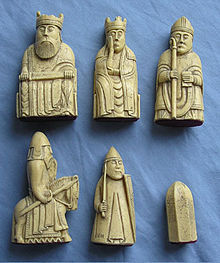History of chess
The history of chess spans some 1500 years. The earliest predecessors of the game originated in India, before the 6th century AD. From India, the game spread to Persia. When the Arabs conquered Persia, chess was taken up by the Muslim world and subsequently spread to Southern Europe. In Europe, chess evolved into roughly its current form in the 15th century. In the second half of the 19th century, modern chess tournament play began, and the first world Chess Championship was held in 1886. The 20th century saw great leaps forward in chess theory and the establishment of the World Chess Federation (FIDE). Developments in the 21st century include use of computers for analysis, which originated in the 1970s with the first programmed chess games on the market. Online gaming appeared in the mid-1990s. The precursors of chess originated in India during the Gupta Empire,[2][3][4][5] where its early form in the 6th century was known as chatura?ga, which translates as "four divisions (of the military)": infantry, cavalry, elephantry, and chariotry, represented by the pieces that would evolve into the modern pawn, knight, bishop, and rook, respectively.[6] Chess was introduced to Persia from India and became a part of the princely or courtly education of Persian nobility.[7] In Sassanid Persia around 600 the name became chatrang, which subsequently evolved to shatranj, and the rules were developed further. Players started calling "Shah!" (Persian for "King!") when attacking the opponent's king, and "Shah Mat!" (Persian for "the king is helpless" Ц see checkmate) when the king was attacked and could not escape from attack. These exclamations persisted in chess as it traveled to other lands. The game was taken up by the Muslim world after the Islamic conquest of Persia, with the pieces largely keeping their Persian names. The Moors of North Africa rendered Persian "shatranj" as sha?erej, which gave rise to the Spanish acedrex, axedrez and ajedrez; in Portuguese it became xadrez, and in Greek zatrikion, but in the rest of Europe it was replaced by versions of the Persian shah ("king"). Thus, the game came to be called ludus scacchorum or s

acc(h)i in Latin, scacchi in Italian, escacs in Catalan, echecs in French (Old French eschecs); schaken in Dutch, Schach in German, szachy in Polish, sahs in Latvian, skak in Danish, sjakk in Norwegian, schack in Swedish, sakki in Finnish, sah in South Slavic languages, sakk in Hungarian and sah in Romanian; there are two theories about why this change happened: From the exclamation "check" or "checkmate" as it was pronounced in various languages. From the first chessmen known of in Western Europe (except Iberia and Greece) being ornamental chess kings brought in as curios by Muslim traders. The Mongols call the game shatar, and in Ethiopia it is called senterej, both evidently derived from shatranj. Chess spread directly from the Middle East to Russia, where chess became known as шахматы (shakhmaty, treated as a plural). The game reached Western Europe and Russia by at least three routes, the earliest being in the 9th century. By the year 1000 it had spread throughout Europe.[8] Introduced into the Iberian Peninsula by the Moors in the 10th century, it was described in a famous 13th century manuscript covering shatranj, backgammon and dice named the Libro de los juegos. Chess spread throughout the world and many variants of the game soon began taking shape.[9] Buddhist pilgrims, Silk Road traders and others carried it to the Far East where it was transformed and assimilated into a game often played on the intersection of the lines of the board rather than within the squares.[9][10] Chaturanga reached Europe through Persia, the Byzantine empire and the expanding Arabian empire.[11] Muslims carried chess to North Africa, Sicily, and Iberia by the 10th century.[9] The game was developed extensively in Europe, and by the late 15th century, it had survived a series of prohibitions and Christian Church sanctions to almost take the shape of the modern game.[12] Modern history saw reliable reference works,[13] competitive chess tournaments[14] and exciting new variants which added to the game's popularity,[14] further bolstered by reliable timing mechanisms (first introduced in 1861), effective rules[14] and charismatic players.